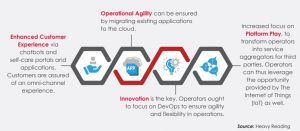For today’s operators, the buck doesn’t stop at merely ensuring profitability and retaining customers. The advent of over-the-top players, rapidly shrinking average revenues per user, et all, have changed long-standing priority lists. Now, the order of the day is to tread the path from communications service providers to digitally-driven entities.
However, here’s the tricky part-this process isn’t confined to building up future-ready networks. A rather vital part is to ensure existing business support systems (BSS) are equally up to speed. For good reason too-these systems manage information pertaining to customers and products, not to mention, collecting revenue.
In this context, Ovum has predicted that annual revenues for the global BSS market will grow from $17 billion in 2017 to $22.5 billion in 2022, a CAGR of 5.8 per cent. Drilling down further, overall growth in the market will be driven by the uptake of more vendor services, which will grow at a CAGR of 6.8 per cent, to $17.1 billion in 2022. Within the services domain, the need for managed services and accelerated growth within SaaS will drive revenue growth for BSS.
The bottom-line is this-operators ought to gear up for the digital telecom space of tomorrow. An important part of this process is investing in digital BSS stacks that are efficient, scalable, flexible and collaborative. However, operators would do well to remember that digitally transforming existing systems and infrastructure isn’t an overnight process. A piecemeal, gradual approach is best suited to ensure maximum success.
WHAT AILS OSS/BSS
As per industry analysts, today’s OSS/BSS stacks have miles to go, before being able to support any plans pertaining to digital transformation. Here’s why-these stacks have been around since operators were setting up their networks. In fact, over the years, these players have added a complex maze of legacy systems and processes. Needless to say, all entailed extremely limited functionality, which, of course, compounded the challenge.
Adding to the chaos is the fact that the sector itself is undergoing such turbulent times. As per Ovum, to maintain a competitive edge, operators are now thinking and planning beyond traditional key performance indicators such as revenue, profit margins, et all. Instead, criteria such as customer experience, efficiency, seamless product delivery, quicker time-to-market and agility have come to the fore. However, given the extent of legacy systems and processes, operators are unable to meet these parameters effectively. In fact, this is expected have a trickle-down impact on their other lines of business as well. For instance, managing scattered systems usually results in duplication of information, which in turn adversely impacts the time-to-market of several products. In a nutshell, revenue leakage, inaccurate billing and absence of an omni-channel customer experience are just a few of the challenges an operator will face with legacy systems.
DIGITAL TRANSFORMATION AND OSS/BSS STACKS
Doubtlessly, digital transformation presents an ideal opportunity for operators to rebuild lost (or crumbling) market positions, innovate and prepare for the future. However, this is easier said than done. Merely planning to monetize next generation technologies isn’t enough. Operators ought to have a plan to leverage these to best suit all aspects of their business-including BSS.
For example, as per Ovum, artificial intelligence (AI) will enable an operator to improve customer experience and enhance the efficiency of various business processes. However, in order to leverage this to the fullest, these players ought to invest in making the IT systems within the BSS domain lean and agile. This can be achieved by consolidating systems and automating multiple processes throughout the revenue and customer management stacks.
ENABLERS OF DIGITAL TRANSFORMATION IN BSS
By modernizing BSS systems, four key aspects of digital transformation come to the fore:
Going forward, telecom operators and vendors alike will continue to scramble to compete in an increasingly digital world. As a result, the former’s expenditure on IT and the latter’s overall revenues are likely to see an upward trend. To illustrate, as per Ovum’s most recent ICT Enterprise Insights survey, over 70 per cent of operators plan to increase IT spend over the next year, with 30 per cent planning to increase spends by 6 per cent or more.
About the Author
BAL MUKUND
Head of Product, Business Solutions
Comviva Technologies
Bal Mukund leads Comviva’s Business Solutions portfolio.
As an experienced techie and product manager, Bal brings a treasure of expertise in Digital BSS Transformation projects. He has continuously worked with telecom service providers to enable cost-effective business solutions.
He has over twenty years of experience in the telecom OSS/BSS domain. Prior to this stint, he worked with Bharti Airtel and Telecom Seychelles Limited. He has continuously worked with telecom service providers to enable cost-effective business solutions. In addition, he has overseen the development of the service delivery platform (SDP) which caters to the fast growing OTT and VAS space.

